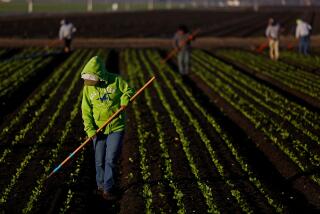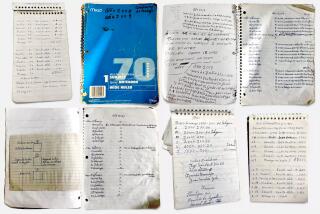Fertile Pampas, Fallow Economy : Argentina: Even with larger harvests, farmers are going broke due to recession and volatile interest rates.
- Share via
BUENOS AIRES — The weather was good to the pampas this year, but bringing prosperity back to one of the world’s most fertile plains takes more than that.
The biggest problem for pampas farmers is not the weather but a national economy in the third year of a recession marked by high inflation, volatile interest and exchange rates, and a severe contraction of real wages.
Leonida Gasoni bought his last new tractor in 1973. “I have two others older than that, and my truck is a 1970,” he said.
“I don’t think I’m very different from other farmers. You change the engine, but you don’t change the vehicle. All our agricultural equipment is very old, obsolete.”
Rain fell on the pampas last spring and a hot, dry Southern Hemisphere summer followed. While crop yields remain better than average, farmers say they are going broke, particularly those who work 500 or fewer acres.
Harvests of corn, sorghum, soybeans and sunflowers were not enough to pay the bills of many farmers, said Gasoni, head of the Cooperative Farm Confederation, which represents most of Argentina’s 400,000 farmers.
Thousands of them blocked roads for two days in March, withheld their produce and refused to pay bills or taxes. Few believe that the wheat about to be sown will produce a profit when it is harvested in November.
In February, the Rural Society of large farms and ranches said sales of fertilizers and agricultural chemicals were down “drastically” and farmers were firing help, renting or selling their land and seeking work in cities.
Its statement said farms “are faced with an economic situation so distressful” it is difficult to find a similar era in Argentine history.
Agricultural subsidies by the U.S. and European Community governments have cut into foreign demand for farm products from Argentina, a leading exporter of wheat, soybeans, corn and sunflower seeds.
Taxes, the price of diesel fuel and transportation costs have soared, and strikes have stopped the railroad cars that carry grain to river and Atlantic Ocean ports.
A combination of world prices, an overvalued exchange rate for the austral currency and the reduced purchasing power of Argentines caused farm income to stagnate.
“A milk producer receives about 20% of what a customer pays” in a supermarket, said Gladys Ramonda, an agricultural engineer with the Argentine Agrarian Federation.
“It’s the same with a wheat producer and a loaf of bread,” she said. “Most of the rest goes to middlemen.”
Raising prices in the domestic market doesn’t help, because people who cannot afford to pay more will buy less.
Borrowing money for planting, harvesting and new equipment is prohibitively expensive because interest rates reflect inflation that was 27% for February alone.
“A loan of 100 million australs (about $10,000) grows to 135 million australs after the first month, 180 to 190 million australs after the next and so on,” said Gasoni, who owns a 1,750-acre cattle and dairy farm in Santa Fe province, north of Buenos Aires.
“Before you get to the next harvest, you’ve lost everything.”
The association of farm equipment manufacturers said sales of harvesters, balers and sowers had dropped to 10% of normal despite several years of good harvests.
A bountiful season in 1988-89 combined with drought in the United States to raise prices for soybeans, Argentina’s main export.
Last year, Argentina’s farmers harvested nearly 40 million tons of grains and oilseeds, which provided two-thirds of a record $12 billion in exports.
Ramonda said, however, that net farm income declined even with the higher sales volume because Argentine farmers must match the subsidized prices of U.S. and European exports.
A trend toward fewer, larger operations has reduced the number of farmers in Argentina to 414,000 in 1988 from 523,000 in 1969, according to census data. The number of dairy farms has fallen in a dozen years from 44,000 to 30,000.
Groups that organized the March 18-19 strike asked the government to develop a farm policy that addresses their problems.
Strike leaders said the exchange rate has been too high or too low in recent years, and credit has ranged from abundant to scarce.
“Under equal conditions, we can outproduce anyone in the world, but conditions aren’t equal,” said Rene Bonetto, a dairy farmer and vice president of the agrarian federation.
“The United States and Europe subsidize their farmers. Argentina taxes its farmers. In the United States and Europe, the governments have an agricultural policy. They know what they want to produce, and when and how. Not Argentina.”
More to Read
Sign up for Essential California
The most important California stories and recommendations in your inbox every morning.
You may occasionally receive promotional content from the Los Angeles Times.













